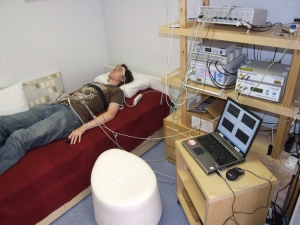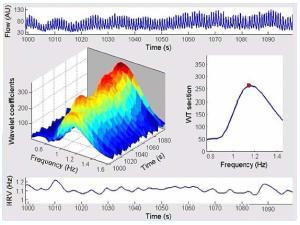Research

Almost all our research is devoted to the understanding of complex phenomena associated with nonlinear oscillators.
Oscillations are a universal phenomenon in living systems. They manifest on all
lengthscales ranging from the molecular, through cellular and organ, up to the
whole-body scale, and even to entire populations. Correspondingly, they are
characterised by a huge range of timescales. Familiar examples include the
heartbeat and respiration, the circadian (day-night) cycle, and ovulation
cycles.
Often, these oscillatory processes interact with each other in very complex
ways that can only be understood through the application of ideas and methods
from nonlinear dynamics. To understand what is happening, we model the
processes with nonlinear oscillators and study their behaviour in the presence
of noise (the random fluctuations from the rest of the system). We propose numerical and theoretical methods to deal with coupled ensembles or individual oscillatory processes in a deterministic and/or stochastic way.
We are especially interested in the influence of the oscillators on each other - their mutual interactions. The resultant modulation and synchronisation phenomena occur in physiology in just the same way that they do for coupled oscillators in physics. Comparison of the model phenomena with physiological data measured for healthy subjects in our laboratory and for patients in our collaborating hospitals is illuminating and characterising diverse conditions and diseases.
|
Applications: We have ongoing or recently-completed studies of oscillatory changes in healthy ageing, anaesthesia, cancer, exercise at altitude, congestive heart failure, hypertension, diabetes mellitus, post-acute myocardial infarction, paraplegia, and tetraplegia. Dynamical Bayesian inference is used to model population cycling in ecology, and for a novel method of secure communication. We study ion channels in cellular membranes, treating the permeating ion as a Brownian particle controlled by Coulomb blockade. Much of our research is being developed in close collaboration with clinicians, so that potentially useful applications can quickly be spotted and evaluated. |
|
Ionic Coulomb blockade in biological ion channels: We are developing novel ionic Coulomb blockade model of permeation and selectivity in biological ion channels. This is a large EPSRC-funded multi-disciplinary and multi-university project carried out in 2015-2018.
BRACCIA Project: Investigated interactions between the brain and cardiovascular oscillations and how they change in anæsthesia.
Publications include "Kenwright et al. Anaesthesia 70, 2015  ".
".
BRACCIA Project
BRACCIA Meeting and Conference


